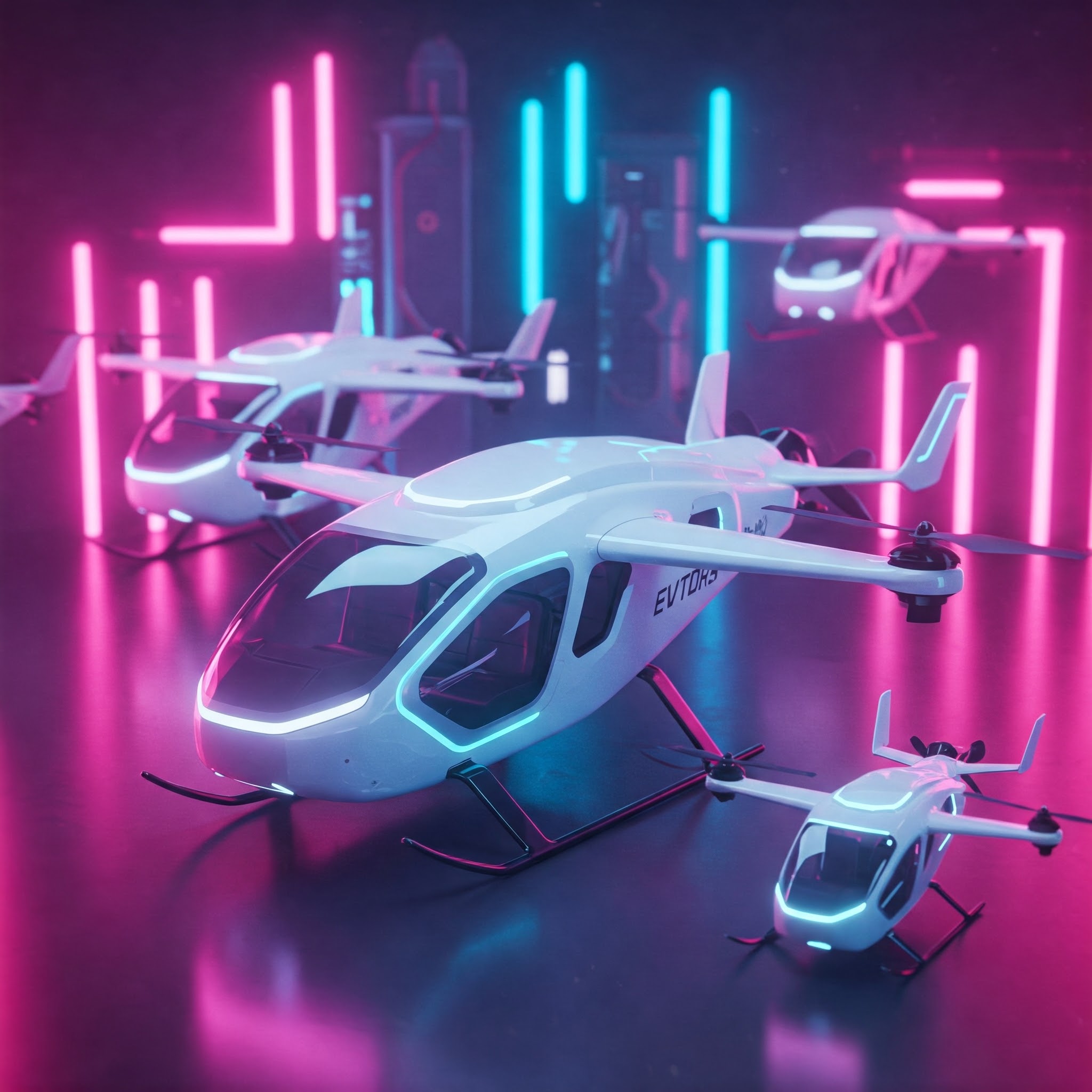Introduction
The concept of flying vehicles has long been the subject of science fiction, but today it is becoming a reality through the development of Electric Vertical Take-Off and Landing (eVTOL) vehicles. eVTOLs represent a transformative innovation in transportation, combining the benefits of electric propulsion with the ability to take off and land vertically. These aircraft are poised to reshape urban mobility, logistics, disaster response, and even tourism, offering a cleaner, quieter, and more efficient alternative to conventional transportation methods.
As cities worldwide become increasingly congested, eVTOLs offer an aerial solution to traffic and accessibility problems, supported by advances in battery technology, autonomous systems, and sustainable energy. This article explores the key features, technology, applications, challenges, and future prospects of eVTOL vehicles, with a focus on their potential in emerging economies like India.
1. What Are eVTOL Vehicles?
eVTOL vehicles are aircraft that use electric power to achieve vertical take-off and landing, without the need for long runways. These vehicles often use multiple rotors or ducted fans, and may be piloted manually, remotely, or fully autonomously. The core idea is to create an eco-friendly, efficient, and space-saving mode of transportation for both people and cargo.
Key Characteristics:
- Powered entirely by electric motors
- Capable of vertical take-off and landing
- Designed for short to medium-range flights (20–300 km)
- Operate at low altitudes (typically below 3,000 feet)
- Can be autonomous or human-piloted
2. How Do eVTOLs Work?
eVTOL aircraft operate based on a combination of aerodynamics, propulsion engineering, and electric power systems. They incorporate various technologies for lift, propulsion, and control.
a) Lift and Propulsion Systems
There are several designs based on the method of lift and thrust:
- Multirotor (e.g., Volocopter): Uses multiple electric propellers for both lift and movement.
- Tilt-rotor (e.g., Bell Nexus): Rotors tilt between vertical and horizontal positions.
- Lift+Cruise (e.g., Joby Aviation): Separate systems for vertical lift and forward cruise.
- Ducted Fans (e.g., Lilium Jet): Enclosed fans within the wings, reducing noise.
b) Battery and Power Management
- Use high-capacity lithium-ion or solid-state batteries
- Advanced Battery Management Systems (BMS) to optimize power usage
- AI and machine learning for energy-efficient flight paths
c) Navigation and Control
- GPS-based positioning
- Inertial navigation systems (INS)
- Onboard AI for collision avoidance and autonomous decision-making
- Fly-by-wire systems replacing mechanical controls
3. Applications of eVTOL Technology
eVTOLs are being designed for various applications across civilian, commercial, and defense sectors:
a) Urban Air Mobility (UAM)
One of the most promising uses is in urban air taxis, designed to transport passengers within or between cities. This is particularly beneficial for congested metropolitan areas.
b) Emergency and Medical Services
- Rapid medical evacuation (air ambulances)
- Delivery of medical supplies to remote or disaster-hit areas
- Surveillance and search operations
c) Cargo and Logistics
eVTOLs can be adapted for cargo delivery, especially where terrain makes traditional transport difficult, such as:
- Mountain regions
- Islands
- Disaster zones
d) Military and Defense
eVTOLs can support tactical transport, surveillance, and unmanned missions, particularly in inaccessible areas or hostile environments.
e) Tourism and Leisure
- Scenic aerial tours in cities and tourist hotspots
- Private eVTOL rides in luxury travel
4. Advantages of eVTOL Vehicles
a) Eco-Friendly
- Zero emissions at the point of use
- Electric propulsion reduces the carbon footprint significantly
- Cleaner alternative to helicopters and short-distance flights
b) Noise Reduction
- Quieter operation compared to helicopters
- Suitable for urban environments due to reduced noise pollution
c) Cost-Effective Operation
- Lower maintenance due to fewer moving parts
- Reduced operational costs over time
- Energy-efficient compared to conventional aircraft
d) Space Efficiency
- Vertical take-off and landing eliminates need for runways
- Can use rooftop pads, vertiports, and helipads in dense urban areas
e) Fast and Time-Saving
- Bypasses ground traffic
- Shortens travel time significantly for intra-city transport
5. Challenges in the Adoption of eVTOLs
a) Battery Limitations
- Limited energy density affects flight range and payload
- Battery weight is a constraint on aircraft design
b) Safety and Certification
- Ensuring airworthiness through rigorous testing
- Certification standards for new designs are still evolving
- Need for robust emergency handling systems
c) Infrastructure Needs
- Development of vertiports, charging stations, and air corridors
- Integration into existing urban transportation systems
d) Air Traffic Management
- Coordinating multiple eVTOLs in low-altitude airspace
- Avoiding collisions with buildings, drones, and birds
e) Regulatory and Policy Issues
- Lack of comprehensive laws governing eVTOL operations
- Licensing, pilot training, and insurance requirements
- Privacy and cybersecurity concerns
6. Leading Companies and Global Developments
a) Key Players in the eVTOL Industry
- Joby Aviation (USA): Working with NASA on urban air mobility
- Volocopter (Germany): Successfully tested air taxis in Dubai and Singapore
- Lilium (Germany): Developing 5-seater jets with ducted fan technology
- Vertical Aerospace (UK): Backed by Rolls Royce and Honeywell
- Archer Aviation (USA): Aiming for commercial operations in 2025
- EHang (China): Autonomous passenger drones in limited commercial use
b) Governmental Support
- USA (FAA): Preparing urban air mobility corridors and certification paths
- Europe (EASA): Developing airworthiness standards for eVTOLs
- UAE: Planning air taxi operations before 2030
- South Korea & Japan: Running pilot programs in smart cities
7. eVTOL in India: Opportunities and Challenges
a) Growing Potential
With rapid urbanization and severe traffic congestion in major cities, India is well-positioned to benefit from eVTOLs.
b) Use Cases in India
- Air taxis in cities like Bengaluru, Delhi, and Mumbai
- Medical transport in remote Himalayan regions
- Supply chain support in Andaman, Lakshadweep, and the Northeast
- Surveillance and logistics in border areas
c) Government Initiatives
- Drone Shakti Scheme: Supports indigenous drone and eVTOL development
- Digital Sky Platform: Enables registration and digital monitoring
- Startup Ecosystem: Rise of tech startups working on electric and aerial mobility
d) Roadblocks in India
- Lack of infrastructure (vertiports, charging)
- Airspace regulation not yet evolved for low-altitude autonomous aircraft
- Public awareness and acceptance is low
- Safety standards and testing facilities still under development
8. Ethical, Social, and Environmental Considerations
a) Equity in Access
- Risk of eVTOLs becoming a luxury service
- Need for affordable pricing models
b) Environmental Concerns
- Battery production and disposal must be managed sustainably
- Land use planning for vertiports must avoid ecological disruption
c) Employment and Skills
- Demand for trained pilots, AI engineers, maintenance staff
- Risk of job displacement in conventional transport industries
d) AI and Automation Risks
- Accountability in case of AI failure or crashes
- Privacy concerns from aerial surveillance
9. Future of eVTOLs: Trends and Projections
a) Autonomous Urban Networks
- Fully autonomous eVTOLs with no pilots onboard
- Integrated with public transport systems
b) Hydrogen and Hybrid Propulsion
- Shift toward hydrogen fuel cells for longer range and faster refueling
- Hybrid eVTOLs for extended flights
c) Swarm and Fleet Management
- AI-managed fleets coordinating thousands of eVTOLs
- Shared mobility models like UberAir or subscription-based services
d) Global Market Forecast
- The eVTOL market is expected to reach $30 billion by 2030
- Over 200 eVTOL aircraft designs are currently in development globally
Conclusion
Electric Vertical Take-Off and Landing (eVTOL) vehicles are not just a futuristic dream; they are fast becoming a practical reality. By offering clean, efficient, and versatile solutions for transportation, logistics, and emergency services, eVTOLs have the potential to redefine mobility in the 21st century.
However, the road—or sky—ahead is full of challenges that require collaboration between governments, private companies, technologists, and civil society. With the right infrastructure, policies, and public engagement, eVTOLs can play a crucial role in achieving sustainable urban development, especially in rapidly growing nations like India.
As technology matures, eVTOLs could become as common as buses and trains, marking a monumental shift in how we perceive distance, time, and urban connectivity.





Thank yyou for the good writeup. It in fact was a amusement account it.
Look advanced to far added agreeable from you! However, how can we communicate?